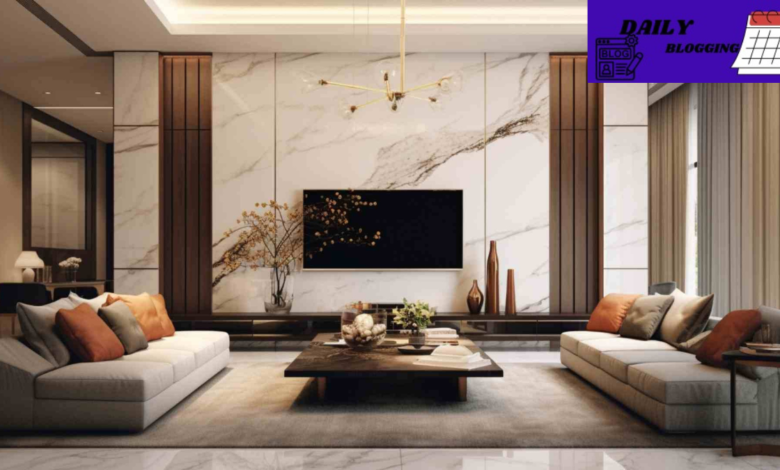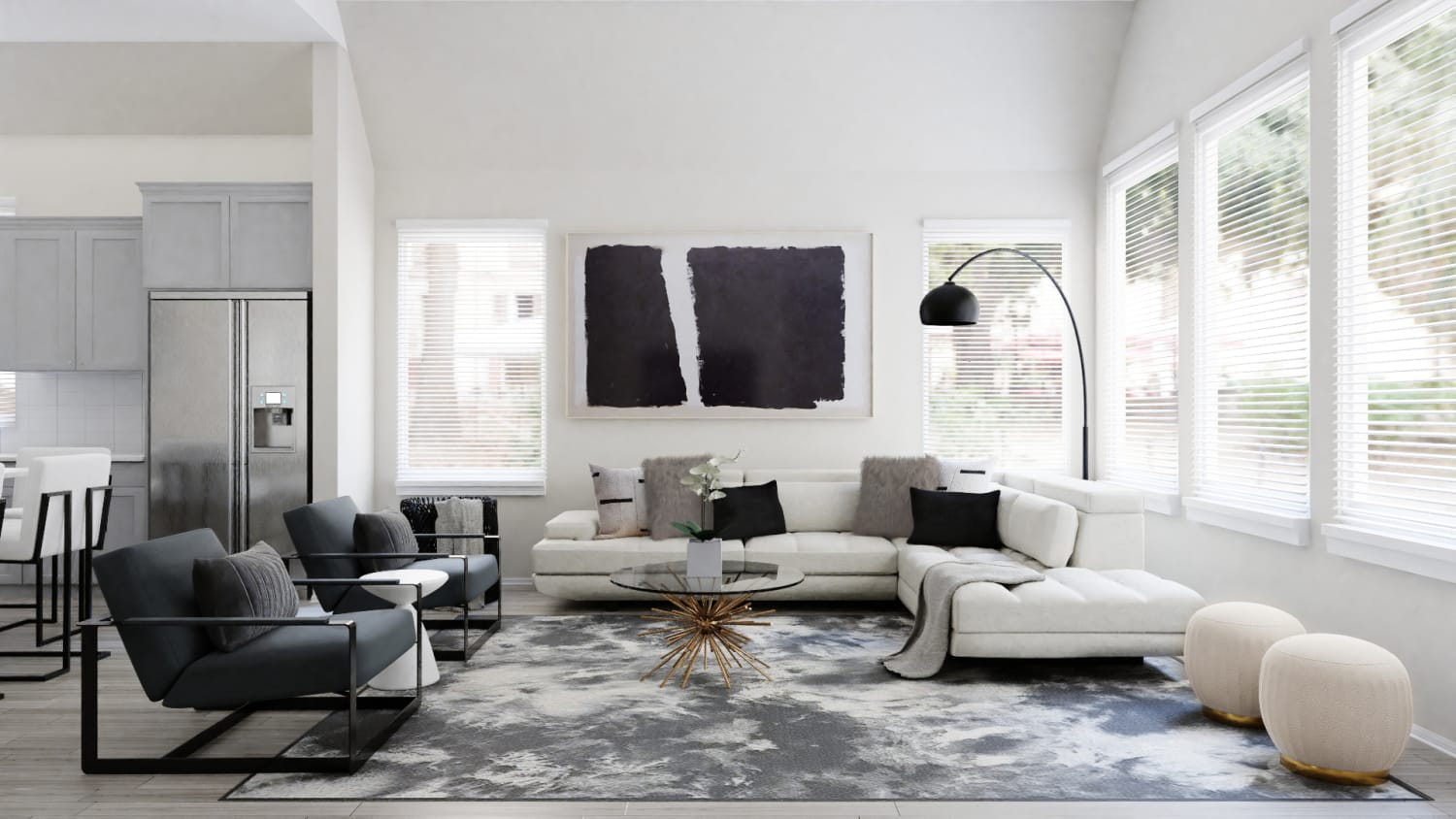Modern Living Room Ideas: Transform Your Space with Style and Comfort

I. Introduction
In today’s fast-paced world, the modern living room is more than just a place to relax—it’s a reflection of your lifestyle, personality, and taste. The modern living room, with its minimalist yet functional design, emphasizes clean lines, sophisticated furniture, and a sense of openness. It’s not just about aesthetics but also about creating a space that is both comfortable and practical. Whether you’re updating your current living room or starting from scratch, understanding key design elements will help you make the right choices for a space that suits your needs and preferences.
Modern living room ideas blend functionality and beauty, making it an ideal spot for relaxation, socializing, and even work. The modern design philosophy revolves around simplicity, open spaces, and the careful selection of furniture and decor. With a focus on quality over quantity, modern living room designs prioritize uncluttered spaces with a few striking pieces of furniture and décor. This guide will explore the essential elements of modern living rooms, including furniture selection, color schemes, layouts, and how to incorporate technology and eco-friendly design into your home. Let’s dive into how you can create a stylish and functional living room with a modern touch.
II. Key Elements of Modern Living Room Design
A. Furniture Selection
One of the hallmarks of modern living room design is its emphasis on clean, sleek furniture that combines form and function. Unlike traditional furniture designs, modern furniture tends to have minimal ornamentation and focuses on simple lines and geometric shapes. A modern sofa is typically low-profile with either straight or slightly curved lines. Materials like leather, linen, and velvet are commonly used for upholstery, offering both luxury and durability.
In modern living rooms, multifunctional furniture is a game-changer. Pieces that serve multiple purposes—such as coffee tables with built-in storage or ottomans that double as seating—help maximize the space while keeping it clutter-free. When selecting furniture, opt for neutral colors like gray, black, or beige for large items like sofas and chairs. Accent pieces, like throw pillows, can introduce bolder colors and textures. Choosing furniture that blends seamlessly with the room’s layout ensures both comfort and style without overwhelming the space.
B. Color Schemes and Textures

Color is a powerful tool in setting the tone for your modern living room. Modern spaces typically favor neutral color palettes, such as whites, grays, and beiges, because they create a serene and inviting atmosphere. These colors also serve as a perfect backdrop for introducing accent colors through furniture, rugs, or artwork. For example, a neutral sofa can be paired with vibrant yellow throw pillows or a deep navy-blue rug for contrast.
Incorporating different textures into the room adds dimension and warmth. A shaggy rug can complement smooth leather furniture, while textured throw blankets or velvet cushions introduce a touch of luxury. Another popular option is mixing matte finishes with shiny surfaces—like pairing a matte coffee table with a glossy lamp base. This adds visual interest and creates a dynamic space. Don’t shy away from experimenting with texture, but ensure the room maintains balance by limiting your palette to a few colors and textures that harmonize well together.
C. Lighting Choices
Lighting is crucial in any modern living room, as it enhances the ambiance and functionality of the space. The key is to make the most of natural light by using large windows, light curtains, or open spaces that allow sunlight to pour in. A room flooded with natural light feels airy and spacious, which is a hallmark of modern design. If natural light is limited, consider strategically placing mirrors to reflect light or using light-colored furniture and walls to brighten up the space.
For artificial lighting, modern living rooms often feature sleek pendant lights, minimalist floor lamps, and recessed lighting. These lighting fixtures should be chosen not only for their aesthetic value but also for their ability to provide proper illumination without overwhelming the room. Consider layered lighting: ambient light for general illumination, task lighting for specific activities like reading, and accent lighting to highlight certain features or art pieces. LED lighting strips, for instance, can be installed under furniture or along the edges of walls for a futuristic touch.
III. Creative Layouts for a Modern Living Room
A. Open Concept Living Room Designs
Open concept layouts are a defining characteristic of modern living rooms. This design choice eliminates unnecessary walls, creating a free-flowing, airy environment where the living room seamlessly integrates with other spaces like the dining room or kitchen. Open floor plans enhance the sense of space, making even smaller areas feel larger. The continuous flow of the space encourages interaction and fosters a more inclusive atmosphere, perfect for entertaining or spending time with family.
When designing an open concept living room, it’s important to divide the space subtly to maintain structure. Use rugs to delineate areas—one for the seating area, another under the dining table or workspace. You can also use furniture to create zones, such as placing a large sectional sofa in a way that defines the living space while leaving the rest of the room open for other uses. Open shelving or strategically placed art can also act as functional room dividers without blocking light or flow.
B. Zoning the Space
While an open concept living room eliminates walls, zoning is essential for maintaining a sense of order and functionality. Zoning refers to the practice of dividing a large living room into specific areas for various activities, such as watching TV, reading, or socializing. The key to successful zoning is ensuring that each space serves a purpose while still contributing to the overall flow of the room.
For instance, a reading nook with a comfortable chair and a floor lamp can be positioned in a quiet corner, creating a peaceful retreat. Meanwhile, the main seating area could be centered around a TV or fireplace for entertainment purposes. Zoning doesn’t necessarily require physical barriers; clever use of furniture arrangement and lighting can define areas without compromising the open, airy feel that defines modern living rooms.
C. Arranging Furniture for Flow and Comfort
When arranging furniture in a modern living room, the goal is to create a comfortable and functional layout while preserving the room’s open feel. Start by determining the focal point of the room—this could be a fireplace, a large piece of art, or a media console. Arrange the seating area around this focal point to create a natural gathering place. Avoid cluttering the room with too many pieces of furniture; instead, opt for strategically placed seating that facilitates easy conversation and movement.
Ensure that pathways between furniture are wide enough for easy flow. In modern living rooms, the layout should be both practical and aesthetically pleasing. Leave enough space between furniture pieces for people to walk around comfortably. The size of your furniture should be proportional to the size of the room; oversized sofas or bulky chairs can make a small room feel cramped. By striking a balance between comfort, style, and flow, you can create a modern living room that feels open and inviting.
IV. Incorporating Technology and Smart Features
A. Smart Home Integration
The modern living room is not just a space for relaxation; it is also a hub for technology. Smart home devices are becoming increasingly popular in modern living room design. From voice-activated assistants like Amazon Alexa or Google Home to smart thermostats and lighting systems, these devices enhance convenience and create a more connected living experience.
When integrating technology, the goal is to keep devices discreet while still reaping the benefits of smart home features. Use furniture with built-in charging ports or hide cables with cord management systems to keep the space tidy. In modern living rooms, technology should complement the design rather than dominate the space.
B. Entertainment Systems
A modern living room is incomplete without a state-of-the-art entertainment system. Modern televisions are sleek and thin, offering the perfect aesthetic for minimalist spaces. Wall-mounted TVs can save space and reduce clutter, creating a cleaner look. Additionally, surround sound systems or soundbars can enhance the viewing experience without taking up too much space.
When setting up an entertainment system, consider the room’s layout to ensure optimal viewing angles. Install TV mounts or media consoles that can hold electronics while maintaining a clean, minimalist design. Disguising wires and devices behind panels or cabinetry keeps the space from feeling cluttered, allowing technology to blend seamlessly into the modern environment.
C. Virtual Reality and Gaming
Incorporating virtual reality (VR) and gaming technology into a modern living room is becoming increasingly popular. Designing a space that accommodates gaming systems and VR stations requires strategic planning to ensure comfort and style. Use modular furniture, such as low-profile sofas or bean bags, to provide a relaxed seating arrangement that can easily be rearranged. Additionally, consider creating a designated gaming zone with a large screen and ergonomic chairs.
The key is to balance functionality with aesthetics. While VR and gaming equipment are often high-tech and bulky, finding ways to incorporate them into your modern living room design without overwhelming the space is essential. By blending technology with thoughtful design, you can create a space that is both visually appealing and high-performing.
V. Sustainable and Eco-Friendly Modern Living Rooms
A. Sustainable Materials and Furniture
As sustainability becomes a more significant consideration in interior design, choosing eco-friendly materials for your modern living room is essential. Look for furniture made from sustainable wood, bamboo, or recycled materials. These materials not only reduce your carbon footprint but also add a unique, organic touch to your space.
Investing in durable, high-quality furniture is a wise choice for eco-conscious consumers. By opting for timeless pieces that won’t need to be replaced every few years, you contribute to a more sustainable lifestyle. Additionally, consider buying second-hand or upcycled furniture to reduce waste while still maintaining a modern aesthetic.
B. Green Living: Incorporating Plants
Indoor plants are a fantastic addition to any modern living room. Not only do they enhance the room’s aesthetic, but they also improve air quality and contribute to a more natural, calming environment. Large, leafy plants like fiddle leaf figs or monstera plants can make a bold statement in a corner or beside a sofa, while smaller plants can be placed on coffee tables or shelves.
Greenery complements the neutral tones and clean lines typically found in modern living rooms, offering a refreshing contrast to the minimalistic design. Choose plants that thrive in indoor environments and require minimal maintenance for the best results. Whether you opt for a statement plant or a series of smaller ones, adding greenery to your living room infuses the space with life and vibrancy.
C. Energy-Efficient Design
Creating an energy-efficient modern living room doesn’t mean sacrificing style for sustainability. Simple design choices, such as using energy-efficient lighting fixtures or incorporating insulated windows, can help reduce your home’s energy consumption. Opt for LED lighting, which uses less energy and lasts longer than traditional bulbs.
Another eco-friendly design idea is incorporating natural materials like stone, wood, or cork, which are both sustainable and stylish. By making conscious choices that prioritize energy efficiency, you can design a modern living room that is not only beautiful but also kind to the environment.
VI. Conclusion
A modern living room blends style, functionality, and comfort, creating a space where you can unwind, entertain, and enjoy time with loved ones. By focusing on key elements like furniture selection, color schemes, and lighting, you can craft a space that feels open, stylish, and inviting. Incorporating smart technology and sustainable practices further elevates the design, making your modern living room both practical and eco-friendly.
With these modern living room ideas, you’re well on your way to transforming your space into a beautiful, functional area that reflects your personal taste while staying true to modern design principles.
VII. Frequently Asked Questions (FAQs)
- What is a modern living room style? Modern living rooms are characterized by clean lines, minimalist furniture, neutral color palettes, and a focus on functionality and comfort.
- What colors work best in a modern living room? Neutral tones like white, gray, and beige create a serene atmosphere, while accents in bolder colors like navy, mustard, or teal can add contrast and interest.
- How can I make my living room feel bigger and more open? Use an open concept layout, incorporate light-colored furniture, and maximize natural light. Mirrors and furniture arrangements can also create the illusion of space.
- Can I incorporate vintage furniture in a modern living room? Yes! Mixing modern and vintage pieces adds character to the room. Focus on keeping the overall aesthetic cohesive by choosing complementary colors and textures.
- How do I choose the right lighting for a modern living room? Opt for sleek, minimalist lighting fixtures like pendant lights, recessed lighting, and floor lamps. Layer your lighting for both function and ambiance.
- Are modern living rooms comfortable? Yes, modern living rooms focus on comfort with quality furniture, ergonomic seating, and thoughtful layouts that ensure relaxation and functionality.
- What are some budget-friendly modern living room ideas? Look for affordable, multipurpose furniture and DIY décor ideas like wall art and upcycled furniture. Choose neutral colors and add character with colorful accessories.
- How can I add personality to a modern living room? Personalize your space with art, statement furniture pieces, and accent colors. Adding plants, rugs, and personal items gives the space warmth and individuality.

